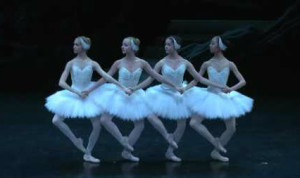While the Choreometrics study focused on the relationship between work movements and dance in pre-industrial societies, I once heard Lomax draw an equally provocative association between European folk dance, ballet, and the advent of the Industrial Revolution in western Europe.
The extent to which all dancers are doing exactly the same thing at the same time varies considerably among folk dance traditions. Certain western European folk dances show a high degree of synchrony, symmetry, and spatial precision, resulting in what Lomax calls “regimented choreographies.” These characteristics become even more obvious in European ballet, according to Lomax. And to demonstrate this point, he showed the “Pas de Quatre” from Swan Lake, in which four ballerinas execute complex footwork rapidly and precisely with interlocked arms. The sequence is almost mechanical in its perfect coordination.

Lomax’s hypothesis was that the uniformity, synchrony, and precision inscribed in this western European movement behavior was a precursor for the highly specialized and synchronized movement necessary for assembly line labor. From a global perspective, it is possible to wonder why the Industrial Revolution occurred first in northern Europe. The conventional answer, of course, is that the steam engine was invented there. And this invention, along with the division of labor, use of standardized parts, and development of the moving assembly line, necessitated adaptations in work movements.
I’ve always been fascinated with Lomax’s hypothesis because it takes the opposite view. That is, he suggests that the Industrial Revolution started in Europe because Europeans were already embodying the uniformity, synchrony, and precision of movement necessary for well-organized industrial production. It would be difficult to substantiate Lomax’s hypothesis. Nevertheless, Lomax’s view suggests that the relationship between movement, social structures, and technology may be more complex that it seems.
